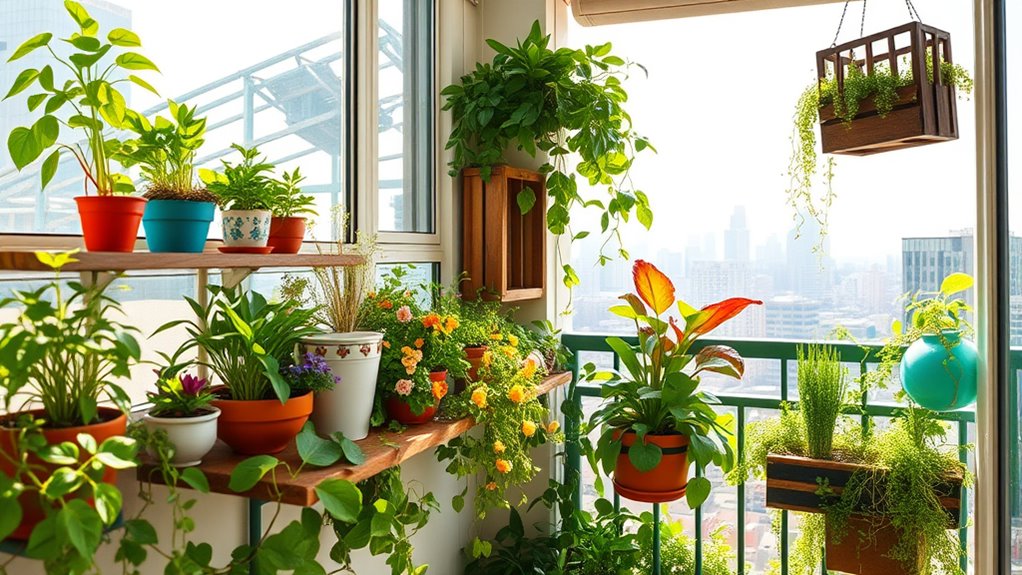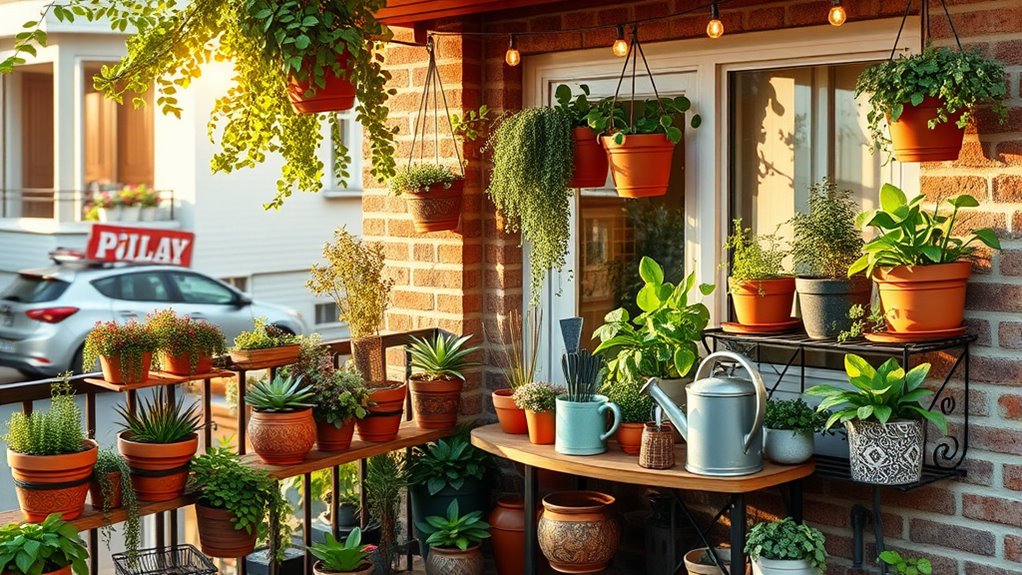To maximize your balcony space, try using vertical planters, stacking containers, and choosing lightweight materials like plastic or resin for mobility. Pair compatible plants such as basil and tomatoes or marigolds and peppers to improve growth and deter pests. Guarantee your containers have proper drainage and are positioned for adequate sunlight. Regularly monitor moisture, avoid overcrowding, and create a balanced mini-ecosystem. Keep exploring these smart tips to turn your balcony into a thriving urban oasis.
Key Takeaways
- Use vertical planters and stacking containers to maximize limited balcony space efficiently.
- Incorporate companion planting to naturally boost plant health and deter pests without chemicals.
- Select lightweight, breathable containers like resin or terracotta for easier mobility and proper soil moisture.
- Arrange plants with varied heights and sunlight needs to optimize space and promote healthy growth.
- Implement smart watering strategies, such as saucers and moisture-retentive containers, to maintain healthy plants in small areas.

Urban gardening can be a rewarding way to grow fresh produce and add greenery to small spaces, even if you think you lack outdoor room. The key is to maximize every inch of your balcony with smart choices and techniques that boost productivity and health of your plants. One effective strategy is companion planting, which involves pairing certain plants together to improve growth, deter pests, and enhance flavors. For example, planting basil alongside tomatoes can protect the tomatoes from pests and boost their flavor, while marigolds can keep harmful insects away from your vegetables. By understanding which plants naturally support each other, you can create a thriving mini-ecosystem right on your balcony.
Maximize your balcony space with companion planting for healthier, more productive urban gardens.
Equally important is container selection. Not all pots and containers are created equal, and choosing the right ones can make a significant difference in your plants’ health. Look for containers with proper drainage holes to prevent waterlogging, which can lead to root rot. Think about the size of your plants and their root systems—smaller herbs need less space, while larger vegetables like peppers or zucchini require bigger pots. Material matters too; lightweight options like plastic or resin are easier to move around, especially if your balcony faces strong sunlight or wind, but terracotta and ceramic pots offer better breathability for roots. You might also consider using vertical planters or stacking containers to save space and add layers of greenery.
When selecting containers, keep in mind that each type may influence soil moisture and temperature differently. For instance, terracotta tends to dry out quickly, so you’ll need to water more frequently. Plastic retains moisture longer, which can be beneficial during hot summer days. Whichever you choose, ensure your containers are placed in spots that get adequate sunlight, and consider using saucers or trays to catch excess water—this protects your balcony and prevents water damage to floors.
Incorporating companion planting into your container garden means you’ll also want to think about the arrangement of your plants. Place compatible pairs close enough to interact beneficially, but avoid overcrowding to prevent disease and promote airflow. Mixing taller plants with shorter ones can also help maximize space and sunlight exposure. As you plan your garden, keep in mind the growth habits of each plant and their water and sunlight needs, so they can thrive together in the limited space. Additionally, understanding the weight of pinball machines can be helpful if you plan to incorporate any heavy equipment or structures into your gardening setup, ensuring your balcony can support the added weight without issue. With thoughtful container selection and strategic companion planting, you can turn your balcony into a lush, productive oasis that offers fresh produce and vibrant greenery all year round.
Frequently Asked Questions
How Can I Prevent Pests Without Chemicals?
To prevent pests without chemicals, you should focus on natural pest control methods. Start by encouraging beneficial insects like ladybugs and lacewings that eat pests. Practice companion planting by pairing plants that repel pests with your vulnerable crops. For example, marigolds deter nematodes and aphids. Regularly inspect your plants for early signs of pests, and remove any affected leaves. These strategies keep pests at bay while keeping your garden chemical-free.
What Are the Best Plants for Low-Light Balconies?
Did you know that over 40% of balcony spaces have limited sunlight? For low-light balconies, shade-loving plants are your best bet. Choose varieties like pothos, snake plants, or ferns, which thrive with minimal sunlight. When practicing low light plant care, make sure you’re not overwatering and avoid direct sun, helping these plants flourish. These options create lush greenery even in the dimmest spaces, turning your balcony into a vibrant oasis.
How Do I Water Efficiently in Small Spaces?
You want to water efficiently in small spaces, so consider using drip irrigation systems. They deliver water directly to the plant roots, reducing waste and saving time. Self-watering pots are another smart choice; they maintain consistent moisture and limit overwatering. By combining these methods, you guarantee your plants stay healthy, conserve water, and make gardening on a balcony more manageable and enjoyable.
Can I Grow Vegetables Year-Round?
Think of your balcony as a year-round vegetable garden oasis. With proper planning, you can grow vegetables year-round by choosing hardy varieties and utilizing microclimates. Incorporate composting tips to enrich your soil naturally, and design your balcony garden with layered containers for ideal space. So, yes, with care and strategy, you can enjoy fresh produce all year, transforming your small space into a thriving, sustainable veggie haven.
What Are Eco-Friendly Balcony Gardening Materials?
When choosing eco-friendly balcony gardening materials, you should focus on sustainable containers like biodegradable pots or recycled planters. Incorporate composting tips to create nutrient-rich soil, reducing waste and reliance on chemical fertilizers. Opt for eco-conscious materials such as bamboo, reclaimed wood, or recycled plastics. These choices help protect the environment while enhancing your garden’s health, making your balcony a greener, more sustainable space for your plants to thrive year-round.
Conclusion
So, embrace your balcony, nurture your plants, and let your creativity flow. Grow your herbs, flowers, and veggies, and enjoy the beauty, the freshness, the joy they bring. Keep experimenting, keep learning, and keep loving your urban oasis. Because your balcony isn’t just a space—it’s a sanctuary, a playground, a reflection of your passion. Turn your small space into a thriving sanctuary, a green retreat, and a vibrant expression of your urban bohemian spirit.










